I need to initialize some three dimensional points, and I want them to be equally spaced throughout a cube. Are there any creative ways to do this?
I am using an iterative Expectation Maximization algorithm and I want my initial vectors to "span" the space evenly.
For example, suppose I have eight points that I want to space equally in a cube sized 1x1x1. I would want the points at the corners of a cube with a side length of 0.333, centered within the larger cube.
A 2D example is below. Notice that the red points are equidistant from eachother and the edges. I want the same for 3D.

In cases where the number of points does not have an integer cube root, I am fine with leaving some "gaps" in the arrangement.
Currently I am taking the cube root of the number of points and using that to calculate the number of points and the desired distance between them. Then I iterate through the points and increment the X, Y and Z coordinates (staggered so that Y doesn't increment until X loops back to 0, same for Z with regard for Y).
If there's an easy way to do this in MATLAB, I'd gladly use it.